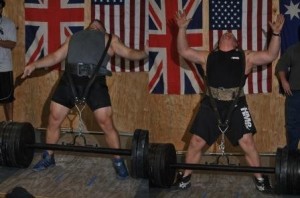Neck Lift
By Eric Todd
With the Heavy Lift Championship on the Calendar for May 5, I was under the assumption that people were going to be wanting to start training. So, I thought I would do a series on how to execute each of the heavy lifts. They are like no other lifts out there, where the lifter is capable of lifting monstrous poundages.
This particular article will focus on the first lift to be contested that day, the neck lift. When I first heard of the neck lift, I envisioned the lift I did in high school with a neck harness I bought at Champs Sports with a 45# weight looped through the chain. I was concerned, as I knew there was no way I could lift hundreds of pounds like this, even though that is where the records stood. As luck would have it, it was not that lift at all, and I was capable of more than I thought.
The rules of the neck lift are as follows:
A Heavy Lift Bar is used in this lift. A neck harness is also used, which fits over the head. Any style of neck harness is acceptable, provided that it is held in place entirely by the head during the lift. The neck harness must not contact the neck or trapezius muscles. A pad, such as a towel, may be placed between the head and the neck harness. An adjustable chain and hook is attached to the neck harness so it may be attached to the Heavy Lift Bar. The lifter assumes a position with the Heavy Lift Bar in front of the lifter or the lifter may straddle it. The feet must parallel and in line with the torso. Width of feet placement is optional. The feet must not move during the lift, but the heels and toes may rise. The lifter may adjust the chain length to his/her preference prior to the lift. The lifter must not touch the chain or straps of the neck harness with the hands during the lift, but the chain or straps may touch the lifter’s body. Hands may touch the body during the lift, but must be free of contact upon completion of the lift. The lift begins at the lifter’s discretion. The lifter is allowed one test lift to check the balance of the weight and to make adjustments to the chain length. The lifter will stand and lift the weights from the platform. The shoulders and torso do not have to be upright upon the finish of the lift. The legs must straighten, but the knees do not need to be locked. Once the weight is motionless, the hands free from the body, and the plates on both ends of the bar are off the platform at the same time, an official will give a command to end the lift.
Some people neck lift with a narrow stance, but I prefer a very wide one. I point my toes outward right next to the plates. With the harness on my head, and the hook in the loop on the bar, I take the straps and spread them out wide so they are more to the outside of my body rather than hanging down in front. I also like to lift my arms up while executing this lift.. At this point, look up, lean back, and drive off your heels. When both sides of the bar come off the ground at the same time, the official will give the down command for a good lift. In the image below, you can see Chad Ullum and myself using very similar styles:
As far as training for the neck lift, I imagine any kind of neck training could be beneficial, such as the neck harness I referenced above or a neck machine. However, I am not sure there is any real substitute for actually neck lifting. The technique takes some getting used to, and it is ideal to condition your neck for the feel of these poundages. Check out the video of Chad’s record setting 900# attempt which was set at the Heavy Lift Championship that was held at York Barbell:
